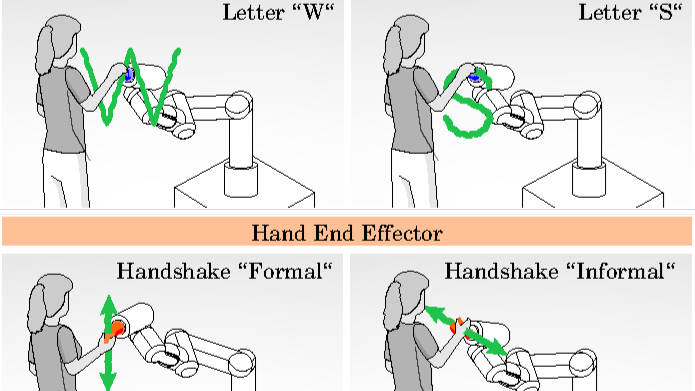Team
Publications:
- Kassem, Khaled; Saad, Alia; Pascher, Max; Schett, Martin; Michahelles, Florian: Push Me: Evaluating Usability and User Experience in Nudge-based Human-Robot Interaction through Embedded Force and Torque Sensors. In: Proceedings of Mensch Und Computer 2024. Association for Computing Machinery, New York, NY, USA, 2024, p. 399-407. doi:10.1145/3670653.3677487AbstractPDFDetailsFull textCitation
Robots are expected to be integrated into human workspaces, which makes the development of effective and intuitive interaction crucial. While vision- and speech-based robot interfaces have been well studied, direct physical interaction has been less explored. However, HCI research has shown that direct manipulation interfaces provide more intuitive and satisfying user experiences, compared to other interaction modes. This work examines how built-in force/torque sensors in robots can facilitate direct manipulation through nudge-based interactions. We conducted a user study (N = 23) to compare this haptic approach with traditional touchscreen interfaces, focusing on workload, user experience, and usability. Our results show that haptic interactions are more engaging and intuitive but also more physically demanding compared to touchscreen interaction. These findings have implications for the design of physical human-robot interaction interfaces. Given the benefits of physical interaction highlighted in our study, we recommend that designers incorporate this interaction method for human-robot interaction, especially at close quarters.
- Pascher, Max; Saad, Alia; Liebers, Jonathan; Heger, Roman; Gerken, Jens; Schneegass, Stefan; Gruenefeld, Uwe: Hands-On Robotics: Enabling Communication Through Direct Gesture Control. In: Companion of the 2024 ACM/IEEE International Conference on Human-Robot Interaction (HRI '24 Companion), March 11--14, 2024, Boulder, CO, USA. ACM, Boulder, Colorado, USA, 2024. doi:10.1145/3610978.3640635AbstractPDFDetailsCitation
Effective Human-Robot Interaction (HRI) is fundamental to seamlessly integrating robotic systems into our daily lives. However, current communication modes require additional technological interfaces, which can be cumbersome and indirect. This paper presents a novel approach, using direct motion-based communication by moving a robot's end effector. Our strategy enables users to communicate with a robot by using four distinct gestures -- two handshakes ('formal' and 'informal') and two letters ('W' and 'S'). As a proof-of-concept, we conducted a user study with 16 participants, capturing subjective experience ratings and objective data for training machine learning classifiers. Our findings show that the four different gestures performed by moving the robot's end effector can be distinguished with close to 100% accuracy. Our research offers implications for the design of future HRI interfaces, suggesting that motion-based interaction can empower human operators to communicate directly with robots, removing the necessity for additional hardware.
- Saad, Alia; Pascher, Max; Kassem, Khaled; Heger, Roman; Liebers, Jonathan; Schneegass, Stefan; Gruenefeld, Uwe: Hand-in-Hand: Investigating Mechanical Tracking for User Identification in Cobot Interaction. In: Proceedings of International Conference on Mobile and Ubiquitous Multimedia (MUM). Vienna, Austria, 2023. doi:10.1145/3626705.3627771AbstractPDFDetailsCitation
Robots play a vital role in modern automation, with applications in manufacturing and healthcare. Collaborative robots integrate human and robot movements. Therefore, it is essential to ensure that interactions involve qualified, and thus identified, individuals. This study delves into a new approach: identifying individuals through robot arm movements. Different from previous methods, users guide the robot, and the robot senses the movements via joint sensors. We asked 18 participants to perform six gestures, revealing the potential use as unique behavioral traits or biometrics, achieving F1-score up to 0.87, which suggests direct robot interactions as a promising avenue for implicit and explicit user identification.
- Saad, Alia; Izadi, Kian; Ahmad Khan, Anam; Knierim, Pascal; Schneegass, Stefan; Alt, Florian; Abdelrahman, Yomna: HotFoot: Foot-Based User Identification Using Thermal Imaging. In: Proceedings of the 2023 CHI Conference on Human Factors in Computing Systems. Association for Computing Machinery, New York, NY, USA, 2023. doi:10.1145/3544548.3580924AbstractDetailsCitation
We propose a novel method for seamlessly identifying users by combining thermal and visible feet features. While it is known that users’ feet have unique characteristics, these have so far been underutilized for biometric identification, as observing those features often requires the removal of shoes and socks. As thermal cameras are becoming ubiquitous, we foresee a new form of identification, using feet features and heat traces to reconstruct the footprint even while wearing shoes or socks. We collected a dataset of users’ feet (N = 21), wearing three types of footwear (personal shoes, standard shoes, and socks) on three floor types (carpet, laminate, and linoleum). By combining visual and thermal features, an AUC between 91.1% and 98.9%, depending on floor type and shoe type can be achieved, with personal shoes on linoleum floor performing best. Our findings demonstrate the potential of thermal imaging for continuous and unobtrusive user identification.
- Abdrabou, Yasmeen; Rivu, Radiah; Ammar, Tarek; Liebers, Jonathan; Saad, Alia; Liebers, Carina; Gruenefeld, Uwe; Knierim, Pascal; Khamis, Mohamed; Mäkelä, Ville; Schneegass, Stefan; Alt, Florian: Understanding Shoulder Surfer Behavior Using Virtual Reality. In: Proceedings of the IEEE conference on Virtual Reality and 3D User Interfaces (IEEE VR). IEEE, Christchurch, New Zealand, 2022. AbstractDetailsCitation
We explore how attackers behave during shoulder surfing. Unfortunately, such behavior is challenging to study as it is often opportunistic and can occur wherever potential attackers can observe other people’s private screens. Therefore, we investigate shoulder surfing using virtual reality (VR). We recruited 24 participants and observed their behavior in two virtual waiting scenarios: at a bus stop and in an open office space. In both scenarios, avatars interacted with private screens displaying different content, thus providing opportunities for shoulder surfing. From the results, we derive an understanding of factors influencing shoulder surfing behavior.
- Saad, Alia; Liebers, Jonathan; Gruenefeld, Uwe; Alt, Florian; Schneegass, Stefan: Understanding Bystanders’ Tendency to Shoulder Surf Smartphones Using 360-Degree Videos in Virtual Reality. In: Proceedings of the 23rd International Conference on Mobile Human-Computer Interaction (MobileHCI). Association for Computing Machinery, Toulouse, France, 2021. doi:10.1145/3447526.3472058AbstractDetailsCitation
Shoulder surfing is an omnipresent risk for smartphone users. However, investigating these attacks in the wild is difficult because of either privacy concerns, lack of consent, or the fact that asking for consent would influence people’s behavior (e.g., they could try to avoid looking at smartphones). Thus, we propose utilizing 360-degree videos in Virtual Reality (VR), recorded in staged real-life situations on public transport. Despite differences between perceiving videos in VR and experiencing real-world situations, we believe this approach to allow novel insights on observers’ tendency to shoulder surf another person’s phone authentication and interaction to be gained. By conducting a study (N=16), we demonstrate that a better understanding of shoulder surfers’ behavior can be obtained by analyzing gaze data during video watching and comparing it to post-hoc interview responses. On average, participants looked at the phone for about 11% of the time it was visible and could remember half of the applications used.
- Liebers, Jonathan; Abdelaziz, Mark; Mecke, Lukas; Saad, Alia; Auda, Jonas; Alt, Florian; Schneegaß, Stefan: Understanding User Identification in Virtual Reality Through Behavioral Biometrics and the Effect of Body Normalization. In: Proceedings of the 40th ACM Conference on Human Factors in Computing Systems (CHI). Association for Computing Machinery, Yokohama, Japan, 2021. doi:10.1145/3411764.3445528AbstractDetailsCitation
Virtual Reality (VR) is becoming increasingly popular both in the entertainment and professional domains. Behavioral biometrics have recently been investigated as a means to continuously and implicitly identify users in VR. Applications in VR can specifically benefit from this, for example, to adapt virtual environments and user interfaces as well as to authenticate users. In this work, we conduct a lab study (N = 16) to explore how accurately users can be identified during two task-driven scenarios based on their spatial movement. We show that an identification accuracy of up to 90% is possible across sessions recorded on different days. Moreover, we investigate the role of users’ physiology in behavioral biometrics by virtually altering and normalizing their body proportions. We find that body normalization in general increases the identification rate, in some cases by up to 38%; hence, it improves the performance of identification systems.
- Saad, Alia; Elkafrawy, Dina Hisham; Abdennadher, Slim; Schneegass, Stefan: Are They Actually Looking? Identifying Smartphones Shoulder Surfing Through Gaze Estimation. In: ETRA. ACM, Stuttgart, Germany, 2020. doi:10.1145/3379157.3391422DetailsCitation
- Saad, Alia; Chukwu, Michael; Schneegass, Stefan: Communicating Shoulder Surfing Attacks to Users. In: MUM 2018: Proceedings of the 17th International Conference on Mobile and Ubiquitous Multimedia. ACM, Cairo, Egypt, 2018. doi:10.1145/3282894.3282919PDFDetailsCitation
- Saad, Alia; Wittig, Nick; Grünefeld, Uwe; Schneegass, Stefan: A Systematic Analysis of External Factors Affecting Gait Identification. . AbstractDetailsCitation
Dataset: https://uni-duisburg-essen.sciebo.de/s/nKHomAwBVa7PPQo





